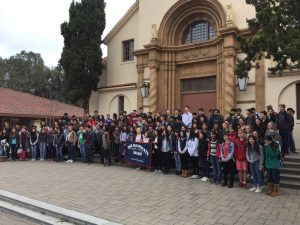Austin: District won’t exclude unvaccinated students, teachers from in-person school
January 24, 2021

Students and staff will not be required to receive the COVID-19 vaccine before returning to in-person school, according to Palo Alto Unified School District Superintendent Don Austin.
“I do not see a scenario where we would self-impose an exclusion of students who are not vaccinated,” Austin said Friday in an interview with The Paly Voice.
Challenges in vaccination rollout have been prevalent state-wide, resulting in the disposal of large batches due to administration and refrigeration issues, and according to Austin, it would be infeasible to mandate vaccination prior to return of all students and staff members.
“Our county is behind [in vaccine administration],” Austin said. “I think our county isn’t going to get caught up.”
A potential decision to bar unvaccinated community members from in-person school would furthermore be a state-wide — not district-wide — decision, according to Austin. And in contrast to a recent statement by Los Angeles Unified School District Superintendent Austin Beutner, who said his district would require vaccinations for students once available, Austin said it would not be within “our local authority to exclude a student for not receiving a vaccine.”
As for teachers and other education workers, Austin was similarly dismissive of the idea that they would be required to get vaccines before returning to school. He said the state may soon shift vaccination prioritization order, first vaccinating those at risk based on age and underlying health conditions as opposed to education workers.
“The whole idea of prioritizing school employees may be crumbling as the state struggles with verification challenges, capacity of testing challenges and healthcare provider challenges,” Austin said, adding that many are questioning the prioritization of “potentially a 25-year-old healthy teacher who’s not teaching in person, versus a 55-year-old with underlying health conditions, that doesn’t have a profession that’s prioritized.”
Another problem with requiring students to get vaccinated has to do with their ages, Austin said, noting that existing vaccine trials have largely excluded patients under the age of 16 — which constitutes the majority of school-aged students. The Pfizer and Moderna vaccines, which have been approved for ages 16 and up and 18 and up respectively, have yet to complete trials for younger groups, and so a vaccine for children will likely not be ready for several more months. Making vaccines mandatory for students is therefore an unrealistic scenario, according to Austin.
“Eighty percent of our students are 16 or under, probably higher than that,” Austin said, adding that the vaccine would thus have “little to do” with students.
Requiring vaccines for staff also seems infeasible, Austin added, as reflected in the distribution of vaccines to healthcare workers in Phase 1A of California’s vaccination plan.
“I don’t know why we would expect teachers or other school employees to flock to the vaccination in higher percentages than health care workers and across the country,” Austin said. “I’m hearing 20% to 40% of healthcare workers are not taking the vaccine. … If it’s true of them, it’s going to be true of teachers as well. And I do not plan to exclude teachers who are not vaccinated from work.”










![A protester in a chicken suit wearing a taco hat with the words “Cluck Trump” at the “No Kings” Democracy Fair in Palo Alto on Saturday. Protestor Mary Chan said she and her husband are horrified at the state of science and medicine in America. “What he [Trump] is doing by defunding scientific research is destroying our academic medical centers, and he’s [Trump] bankrupting rural medical centers,” Chan said. “We will have lasting negative impacts on American health for decades.”](https://palyvoice.com/wp-content/uploads/2025/10/11562FFE-9912-4152-BB01-582426B52ECB_1_105_c-225x300.jpeg)